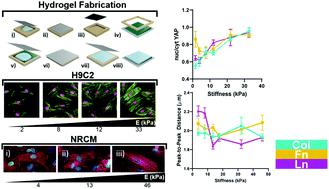当前位置:
X-MOL 学术
›
Biomater. Sci.
›
论文详情
Our official English website, www.x-mol.net, welcomes your
feedback! (Note: you will need to create a separate account there.)
Interrogating cardiac muscle cell mechanobiology on stiffness gradient hydrogels
Biomaterials Science ( IF 5.8 ) Pub Date : 2021-09-20 , DOI: 10.1039/d1bm01061a Ian L Chin 1 , Livia Hool 1, 2 , Yu Suk Choi 1
Biomaterials Science ( IF 5.8 ) Pub Date : 2021-09-20 , DOI: 10.1039/d1bm01061a Ian L Chin 1 , Livia Hool 1, 2 , Yu Suk Choi 1
Affiliation

|
Extracellular matrix (ECM) remodeling is a major facet of cardiac development and disease, yet our understanding of cardiomyocyte mechanotransduction remains limited. To enhance our understanding of cardiomyocyte mechanosensation, we studied stiffness-driven changes to cell morphology and mechanomarker expression in H9C2 cells and neonatal rat cardiomyocytes (NRCMs). Linear stiffness gradient polyacrylamide hydrogels (2–33 kPa) coated with ECM proteins including Collagen I (Col), Fibronectin (Fn) or Laminin (Ln) were used to represent necrotic, healthy, and infarcted cardiac tissue on a continuous stiffness gradient. Cell size, cell shape and nuclear size were found to be mechanosensitive in H9C2 cells, as was the expression or nuclear translocalization of the mechanomarkers Lamin-A, YAP, and MRTF-A. Minor differences were observed between the different ECM coatings, with the same overarching stiffness-dependent trends being observed across Col, Fn and Ln coated hydrogels. Inhibition of mechanotransduction in H9C2 cells using blebbistatin or Y27632 resulted in disruptions to cell shape, nuclear shape, and nuclear size, however, trends in cell size and mechanomarker expression were not significantly attenuated. Mechanosensation in NRCMs was much less marked, with no significant changes in cell morphology being detected, although YAP did become increasingly nuclear localized with increasing stiffness. In α-actinin positive cells, striations formed with regular structure and frequency at all stiffnesses for Col and Fn coated hydrogels, but not Ln coated gels. In this study, we used our stiffness gradient hydrogels to comprehensively map the relationship between ECM stiffness and cardiac cell phenotype and found that less mature H9C2 cardiac cells are more sensitive to ECM changes than the more developed neonatal cardiomyocytes.
中文翻译:

研究刚度梯度水凝胶的心肌细胞力学生物学
细胞外基质 (ECM) 重塑是心脏发育和疾病的一个主要方面,但我们对心肌细胞机械转导的理解仍然有限。为了增强我们对心肌细胞机械感觉的理解,我们研究了 H9C2 细胞和新生大鼠心肌细胞 (NRCM) 中细胞形态和机械标志物表达的刚度驱动变化。涂有包括胶原蛋白 I (Col)、纤连蛋白 (Fn) 或层粘连蛋白 (Ln) 在内的 ECM 蛋白的线性刚度梯度聚丙烯酰胺水凝胶 (2–33 kPa) 用于在连续刚度梯度上表示坏死、健康和梗塞的心脏组织。发现细胞大小、细胞形状和核大小在 H9C2 细胞中是机械敏感的,机械标志物 Lamin-A、YAP 和 MRTF-A 的表达或核转位也是如此。在不同的 ECM 涂层之间观察到微小的差异,在 Col、Fn 和 Ln 涂层的水凝胶中观察到相同的总体刚度依赖性趋势。使用 blebbistatin 或 Y27632 抑制 H9C2 细胞中的机械转导导致细胞形状、核形状和核大小的破坏,但是,细胞大小和机械标志物表达的趋势没有显着减弱。NRCM 中的机械感觉不那么明显,没有检测到细胞形态的显着变化,尽管随着刚度的增加,YAP 确实变得越来越核定位。在 α-肌动蛋白阳性细胞中,对于 Col 和 Fn 包被的水凝胶,在所有硬度下形成具有规则结构和频率的条纹,但不是 Ln 包被的凝胶。在这项研究中,
更新日期:2021-09-20
中文翻译:

研究刚度梯度水凝胶的心肌细胞力学生物学
细胞外基质 (ECM) 重塑是心脏发育和疾病的一个主要方面,但我们对心肌细胞机械转导的理解仍然有限。为了增强我们对心肌细胞机械感觉的理解,我们研究了 H9C2 细胞和新生大鼠心肌细胞 (NRCM) 中细胞形态和机械标志物表达的刚度驱动变化。涂有包括胶原蛋白 I (Col)、纤连蛋白 (Fn) 或层粘连蛋白 (Ln) 在内的 ECM 蛋白的线性刚度梯度聚丙烯酰胺水凝胶 (2–33 kPa) 用于在连续刚度梯度上表示坏死、健康和梗塞的心脏组织。发现细胞大小、细胞形状和核大小在 H9C2 细胞中是机械敏感的,机械标志物 Lamin-A、YAP 和 MRTF-A 的表达或核转位也是如此。在不同的 ECM 涂层之间观察到微小的差异,在 Col、Fn 和 Ln 涂层的水凝胶中观察到相同的总体刚度依赖性趋势。使用 blebbistatin 或 Y27632 抑制 H9C2 细胞中的机械转导导致细胞形状、核形状和核大小的破坏,但是,细胞大小和机械标志物表达的趋势没有显着减弱。NRCM 中的机械感觉不那么明显,没有检测到细胞形态的显着变化,尽管随着刚度的增加,YAP 确实变得越来越核定位。在 α-肌动蛋白阳性细胞中,对于 Col 和 Fn 包被的水凝胶,在所有硬度下形成具有规则结构和频率的条纹,但不是 Ln 包被的凝胶。在这项研究中,











































 京公网安备 11010802027423号
京公网安备 11010802027423号